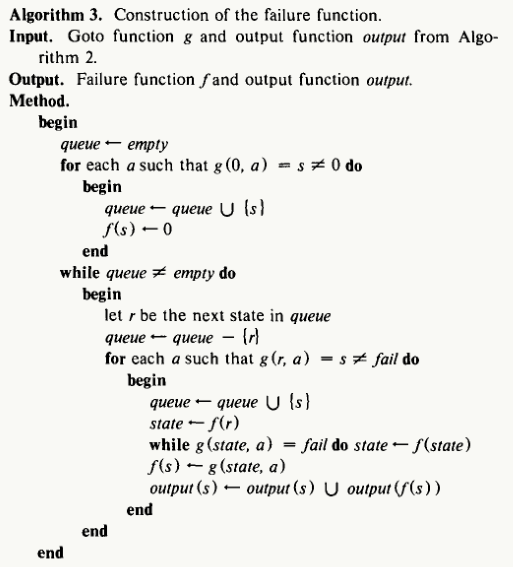1. 多模匹配
AC自动机(Aho-Corasick Automaton)是多模匹配算法的一种。所谓多模匹配,是指在字符串匹配中,模式串有多个。前面所介绍的KMP、BM为单模匹配,即模式串只有一个。假设主串T[1⋯m],模式串有k个P={P1,⋯,Pk},且模式串集合的总长度为n。如果采用KMP来匹配多模式串,则算法复杂度为:

而KMP并没有利用到模式串之间的重复字符结构信息,每一次的匹配都需要将主串从头至尾扫描一遍。贝尔实验室的Aho与Corasick于1975年基于有限状态机(finite state machines)提出AC自动机算法[1]。小插曲:实际上AC算法比KMP提出要早,KMP是1977年才被提出来了的。
2. AC算法
AC自动机
自动机由状态(数字标记的圆圈)和转换(带标签的箭头)组成,每一次转换对应一个字符。AC算法的核心包括三个函数:goto、failure、output;这三个函数构成了AC自动机。对于模式串{he, his, hers, she},goto函数表示字符按模式串的转移,暗含了模式串的共同前缀的字符结构信息,如下图:

failure函数表示匹配失败时退回的状态:

output函数表示模式串对应于自动机的状态:

完整的AC自动机如下:

匹配
AC算法根据自动机匹配模式串,过程比较简单:从主串的首字符、自动机的初始状态0开始,
- 若字符匹配成功,则按自动机的goto函数转移到下一状态;且若转移的状态对应有output函数,则输出已匹配上的模式串;
- 若字符匹配失败,则递归地按自动机的failure函数进行转移
匹配母串的算法如下:

构造
AC自动机的确简单高效,但是如何构造其对应的goto、failure、output函数呢?首先来看goto函数,细心一点我们发现goto函数本质上就是一棵带有回退指针的trie树,利用模式串的共同前缀信息,与output函数共同表示模式串的字符结构的信息。
failure函数是整个AC算法的精妙之处,用于匹配失败时的回溯;且回溯到的状态statestate应满足:状态statestate能按当前状态的转移字符进行能goto到的状态,且能构成最长匹配。记g(r,a)=s表示状态r可以按字符a goto到状态s,则称状态r为状态s的前一状态,字符a为状态s的转移字符。failure函数满足这样一个规律:当匹配失败时,回溯到的状态为前一状态的failure函数值(我们称之为failure转移状态)按转移字符能goto到的状态;若不能,则为前一状态的failure转移状态的failure转移状态按转移能goto到的状态;若不能,则为......上面的话听着有点拗口,让我们以上图AC自动机为例子来说明:
- 对于状态7,前一状态6的failure转移状态为0,状态0按转移字符s可以goto到状态3,所以状态7的failure函数f(7)=3;
- 对于状态2,前一状态1的failure转移状态为0,状态0按转移字符e可以goto到状态0,所以状态2的failure函数f(2)=0;
其中,所有root节点(状态0)能goto到的状态,其failure函数值均为0。根据goto表(trie树)的特性,可知某一状态的前一状态、转移字符是唯一确定的。因此定义β(s)=r表示状态s的前一状态为r,τ(s)=a指状态s的转移字符为a;记fi(s)=f(f(i−1)(s))。那么,状态s的failure函数的计算公式为:

在计算failure函数时,巧妙地运用队列进行递归构造,具体实现如下:

3. 实现
Talk is cheap, show me the code. Java版实现在这里;下面给出python实现(代码参考了 Implementation of the Aho-Corasick algorithm in Python):
from collections import deque, namedtuple
automaton = []
Node = namedtuple("Node", "state value goto failure output")
def init_trie(words):
"""
creates an AC automaton, firstly create an empty trie, then add words to the trie
and sets fail transitions
"""
create_empty_trie()
map(add_word, words)
set_fail_transitions()
def create_empty_trie():
""" initialize the root of the trie """
automaton.append(Node(0, '', {}, 0, set()))
def add_word(word):
"""add word into trie"""
node = automaton[0]
for char in word:
if goto_state(node, char) is None:
next_state = len(automaton)
node.goto[char] = next_state
automaton.append(Node(next_state, char, {}, 0, set()))
node = automaton[next_state]
else:
node = automaton[goto_state(node, char)]
node.output.add(word)
def goto_state(node, char):
"""goto function"""
if char in node.goto:
return node.goto[char]
else:
return None
def set_fail_transitions():
"""construction of failure function, and update the output function"""
queue = deque()
for char in automaton[0].goto:
s = automaton[0].goto[char]
queue.append(s)
automaton[s] = automaton[s]._replace(failure=0)
while queue:
r = queue.popleft()
node = automaton[r]
for a in node.goto:
s = node.goto[a]
queue.append(s)
state = node.failure
while goto_state(automaton[state], a) is None and state != 0:
state = automaton[state].failure
if state == 0 and goto_state(automaton[state], a) is None:
goto_a = 0
else:
goto_a = automaton[state].goto[a]
automaton[s] = automaton[s]._replace(failure=goto_a)
fs = automaton[s].failure
automaton[s].output.update(automaton[fs].output)
def search_result(strings):
"""AC pattern matching machine"""
result_set = set()
node = automaton[0]
for char in strings:
while goto_state(node, char) is None and node.state != 0:
node = automaton[node.failure]
if node.state == 0 and goto_state(node, char) is None:
node = automaton[0]
else:
node = automaton[goto_state(node, char)]
if len(node.output) >= 1:
result_set.update(node.output)
return result_set
init_trie(['he', 'she', 'his', 'hers'])
print search_result("ushersm")
-------------------------------------------------------- 2016-06-14 更新 --------------------------------------------------------
实现了一个scala版本,支持添加词属性,代码托管在Github。
4. 参考资料
[1] Aho, Alfred V., and Margaret J. Corasick. "Efficient string matching: an aid to bibliographic search." Communications of the ACM 18.6 (1975): 333-340.
[2] Pekka Kilpeläinen, Lecture 4: Set Matching and Aho-Corasick Algorithm.